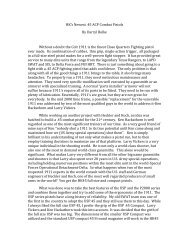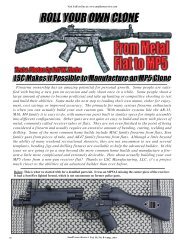DO WE NEED A NEW SERVICE RIFLE CARTRIDGE? - HKPro.com
DO WE NEED A NEW SERVICE RIFLE CARTRIDGE? - HKPro.com
DO WE NEED A NEW SERVICE RIFLE CARTRIDGE? - HKPro.com
You also want an ePaper? Increase the reach of your titles
YUMPU automatically turns print PDFs into web optimized ePapers that Google loves.
5.56 NATO ROUNDTABLE JIM SCHATZ<br />
ammo and instead use the 70 grain Optimal<br />
“Brown Tip,” 77 grain MK262 MOD<br />
1, 62 grain MK255 MOD 1 R2LP, and 62<br />
grain MK318 MOD 0 SOST ammunition<br />
because of their vastly improved terminal<br />
performance against both unprotected<br />
and protected human targets and<br />
continue to develop and field <strong>com</strong>pact<br />
7.62x51mm carbines (HK417, KAC SR-<br />
25K Carbine, LMT MRP/L129A1, LaRue<br />
OBR or FN SCAR Heavies).<br />
3. The U.S. Army has spent 15+ years and<br />
over $120M developing NLT three iterations<br />
of an improved 5.56x45mm M855A1<br />
round to address numerous terminal effectiveness<br />
<strong>com</strong>plaints and <strong>com</strong>bat failure<br />
reports (at all engagement ranges from<br />
CQB to over 500 meters) from at least<br />
as far back as U.S. <strong>com</strong>bat operations in<br />
Somalia in the early 1990s and certainly<br />
post 9/11. The U.S. Army fired more than<br />
1M rounds during the development of the<br />
radically new M855A1 round as part of a<br />
concerted and focused major effort to replace<br />
the SS109-type M855 “penetrator”<br />
round deemed ineffective in modern <strong>com</strong>bat.<br />
The projectile design of the M855A1<br />
is radically different that that of all other<br />
SS109-type ammunition used throughout<br />
NATO, and for very good reason.<br />
4. USSOCOM/NSWC Crane/ATK-Federal<br />
jointly developed the highly effective<br />
5.56x45mm MK318 MOD 0 SOST round<br />
to specifically replace the M855 round<br />
based on documented <strong>com</strong>bat failures<br />
and its larger SOST cousin the 7.62x51mm<br />
MK319 MOD 0 round. These rounds have<br />
been fielded within USSOCOM and the<br />
USMC (5.56x45mm) with excellent results<br />
to date, and are highly sought after<br />
by other NATO SOF units and federal law<br />
enforcement agencies.<br />
5. BAE Systems is developing and the UK<br />
MoD is testing a new 5.56x45mm “High<br />
Performance” projectile/round to improve<br />
long range performance and lethality on<br />
unprotected and light skinned vehicle targets<br />
as a possible replacement to the current<br />
5.56x45mm L2A2 Ball round sometime<br />
after planned 2011 trials are <strong>com</strong>pleted.<br />
There is also an independent ongoing effort<br />
in the UK in 2010 to revisit and evaluate the<br />
medium-caliber .280 British round (and<br />
other medium-caliber options) as a possible<br />
replacement to the 5.56x45mm and<br />
possibly 7.62x51mm cartridge(s) in a modern<br />
assault rifle platform.<br />
6. At time of writing at least one NATO<br />
SOF unit is still developing a mediumcaliber<br />
cartridge/platform to increase the<br />
terminal performance of a <strong>com</strong>pact M4-<br />
style platform based upon <strong>com</strong>bat failures<br />
of 5.56x45mm SS109-style ammunition<br />
during <strong>com</strong>bat operations in Iraq and Afghanistan.<br />
7. The German Bundeswehr has written<br />
a classified report detailing the repeated<br />
<strong>com</strong>bat failures of their SS109-style<br />
5.56x45mm NATO DM11 round and have<br />
as a result (like the UK) issued an Urgent<br />
Requirement for 7.62x51mm semiautomatic<br />
rifles for use by German troops in<br />
Afghanistan. They have also initiated<br />
the design of a new modular, non-caliber<br />
specific assault rifle and will soon field a<br />
lightweight 7.62x51mm general-purpose<br />
machine gun (GPMG) to replace the MG3<br />
GPMG and some 5.56x45mm MG4 light<br />
machine guns to deal with long range and<br />
protected targets that the 5.56x45mm<br />
round is not defeating.<br />
8. The very latest new assault rifle platforms<br />
(Beretta ARX-160, Czech Republic<br />
CZ 805 A, Taiwan T97 and SCAR Common<br />
Receiver) exist after the costs of millions<br />
in R&D and are caliber- convertible by the<br />
operator beyond just 5.56x45mm NATO.<br />
9. USSOCOM and FN are developing<br />
a single, “Common” or universal SCAR<br />
rifle receiver that can be converted into<br />
other calibers to include 7.62x51mm<br />
NATO, medium-calibers (6.8x43mm<br />
Rem. SPC and 7.62x39mm Russian) and<br />
5.56x45mm NATO.<br />
10. The U.S. Army and U.S. Navy continue<br />
to pull from Anniston Army Depot<br />
and the NSWC in Crane, Indiana and then<br />
modify and field additional mothballed<br />
7.62x51mm NATO M14 rifles to be fielded<br />
to front line units as Squad Designated<br />
Marksman’s Rifles (SDMRs) to better deal<br />
with long range and protected targets not<br />
defeated by current 5.56x45mm platforms.<br />
11. The Canadian military is open to and<br />
investigating the merits of a new caliber<br />
and/or projectile in their ongoing SARP<br />
(Small Arms Replacement Program) effort<br />
for the future Canadian DoD family of<br />
small arms to be fielded through 2022.<br />
12. Many experienced law enforcement<br />
snipers/counter snipers no longer employ<br />
5.56x45mm/.223 Remington caliber<br />
sniper rifles even though they can employ<br />
superior non-Hague <strong>com</strong>pliant expanding<br />
hollow-point, polytip-style projectiles<br />
because this cartridge is simply not<br />
considered an effective “one-shot manstopper”.<br />
(The author personally knows<br />
of one such failure that resulted in the<br />
tragic death of an Arlington County Virginia<br />
SWAT officer killed when the assailant<br />
killed him with a shotgun after being<br />
drilled dead center mass in the torso with<br />
a 55 grain M193 FMJ 5.56x45mm round<br />
at less than 100 yards.)<br />
13. A June 2009 report <strong>com</strong>piled for elements<br />
of the Canadian DoD concluded that<br />
to enhance their ammunition effectiveness<br />
it must “abandon the C77 FMJ (SS109-<br />
style) cartridge and replace it with a round<br />
loaded with a SOST/TOTM projectile,” or<br />
field a 6.8x43mm Rem. SPC round or a<br />
7.62x51mm platform as a third option.<br />
14. U.S. troops in Afghanistan are calling<br />
for additional 7.62x51mm MK48 light machine<br />
guns to augment and/or outright replace<br />
5.56x45mm M249 SAW to effectively<br />
deal with longer range, protected targets<br />
and suppression deficiencies encountered<br />
with 5.56x45mm platforms.<br />
15. The U.S. Army has left caliber or projectile<br />
style open in the requirements for<br />
the pending new “Individual Carbine” full<br />
and open <strong>com</strong>petition and is investigating/<br />
modeling other projectiles and calibers in<br />
support of this and other new Army small<br />
arms initiatives.<br />
16. The 2006 U.S. Joint Service Wound<br />
Ballistics Integrated Product Team<br />
(JSWB-IPT) report re<strong>com</strong>mended, and<br />
data developed from more than 10,000<br />
test shots from 3–300 meters, to include<br />
those taken with M855, MK262 MOD 1,<br />
6.8x43mm Rem. SPC, 7.62x39mm and<br />
7.62x51mm NATO, supported the conclusion<br />
that in terms of terminal performance<br />
the optimum caliber for assault rifle<br />
use was not 5.56x45mm NATO nor the<br />
M855/SS109-style projectile. In fact, the<br />
331 page draft (interim) report dated 12<br />
April 2006 stated, “The best performing<br />
systems emphasizing tissue damage, on<br />
the average, in this study were of larger<br />
caliber than 5.56mm” and, “The 6.8mm<br />
performance observed in this test suggests<br />
that an intermediate caliber is the<br />
An M16 rifle sets in a V-<br />
notch stake with a target<br />
in the background, as a<br />
reminder of the annual<br />
weapons qualifications<br />
the Army Reserve<br />
units are required to go<br />
through, at Fort Pickett,<br />
Va., Nov. 21, 2009. (U.S.<br />
Army photo by Spc. Jeff<br />
Daniel/Released)<br />
122 SPRING 2011 SPRING 2011 123






